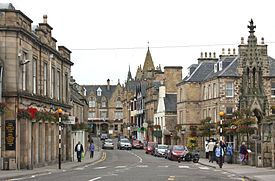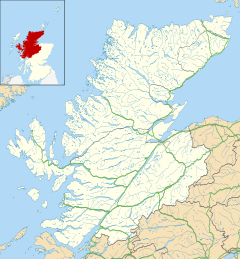Tain, Scotland
Tain
|
|
|---|---|
 |
|
| Tain shown within the Highland council area | |
| Population | 3,972 |
| OS grid reference | NH779821 |
| Council area | |
| Lieutenancy area | |
| Country | Scotland |
| Sovereign state | United Kingdom |
| Post town | TAIN |
| Postcode district | IV19 |
| Dialling code | 01862 |
| Police | Scottish |
| Fire | Scottish |
| Ambulance | Scottish |
| EU Parliament | Scotland |
| UK Parliament | |
| Scottish Parliament | |
Tain (Gaelic: Baile Dhubhthaich) is a royal burgh and parish in the County of Ross, in the Highlands of Scotland.
The English name derives from the nearby River Tain, the name of which comes from an Indo-European root meaning 'flow'. The Gaelic name, Baile Dubhthaich, means 'Duthac's town', after a local saint also known as Duthus.
Tain has an oceanic climate (Köppen Cfb)
Tain railway station is on the Far North Line. The station is unmanned; in its heyday it had 30 staff. The station was opened by the Highland Railway on 1 January 1864. From 1 January 1923, the station was owned by the London Midland and Scottish Railway. Then in 1949 the British railways were nationalised as British Railways. When the railways were privatised the station became part of ScotRail.
Notable buildings in the town include Tain Tolbooth and St Duthus Collegiate Church. The town also has a local history museum, Tain Through Time, and the Glenmorangie distillery.
Tain has two primary schools -Craighill (pupils - 274, April 2011) and Knockbreck (pupils - just under 120, April 2011) - and a secondary school called Tain Royal Academy with 500 pupils in summer 2014.
Tain was granted its first royal charter in 1066, making it Scotland's oldest Royal Burgh, commemorated in 1966 with the opening of the Rose Garden by Queen Elizabeth, the Queen Mother. The 1066 charter, granted by King Malcolm III, confirmed Tain as a sanctuary, where people could claim the protection of the church, and an immunity, in which resident merchants and traders were exempt from certain taxes. These led to the development of the town.
...
Wikipedia

